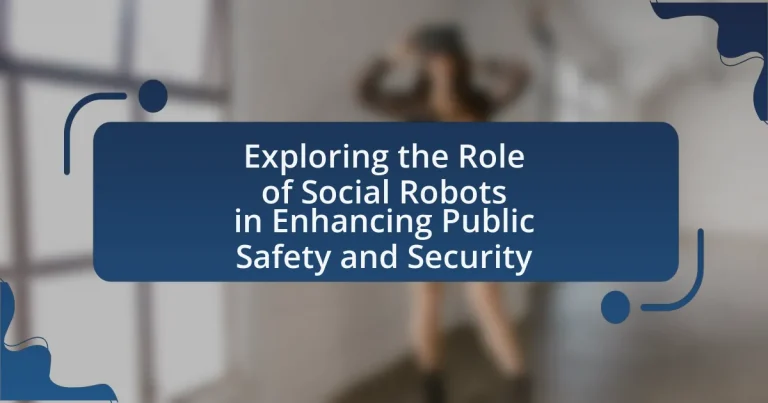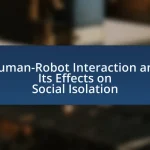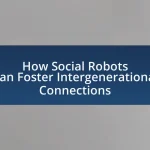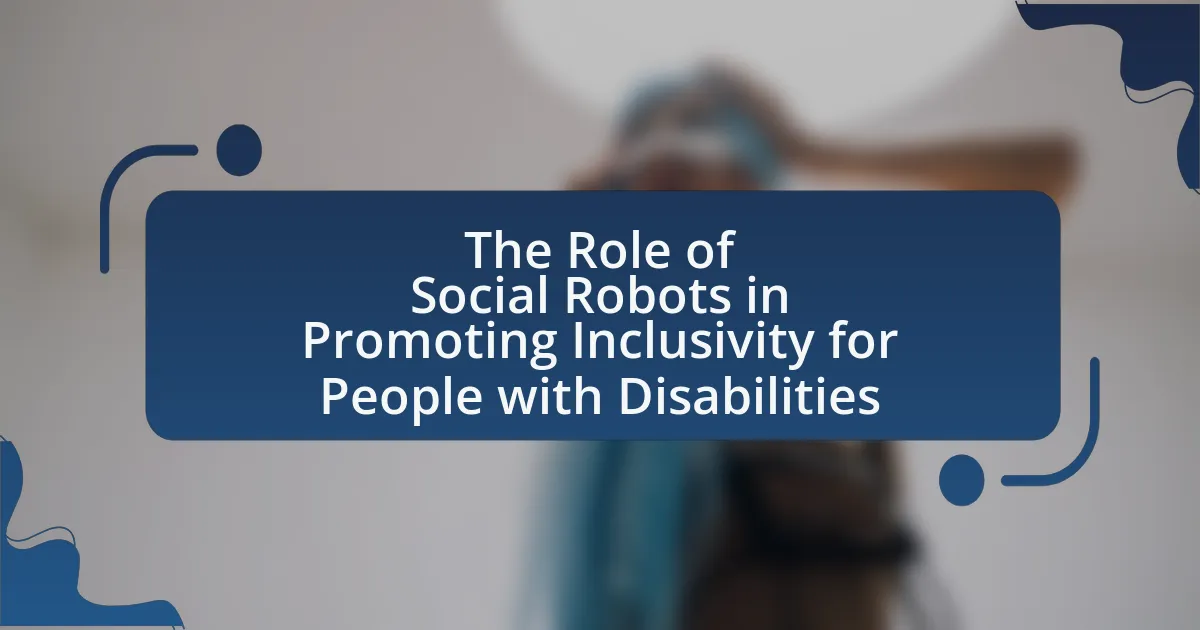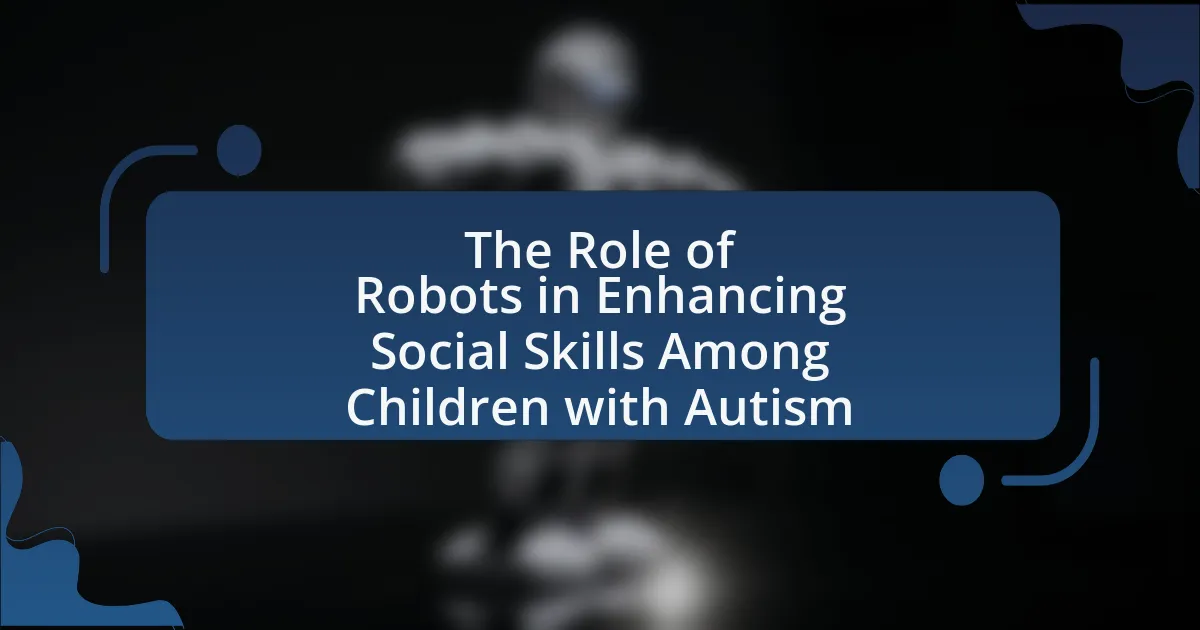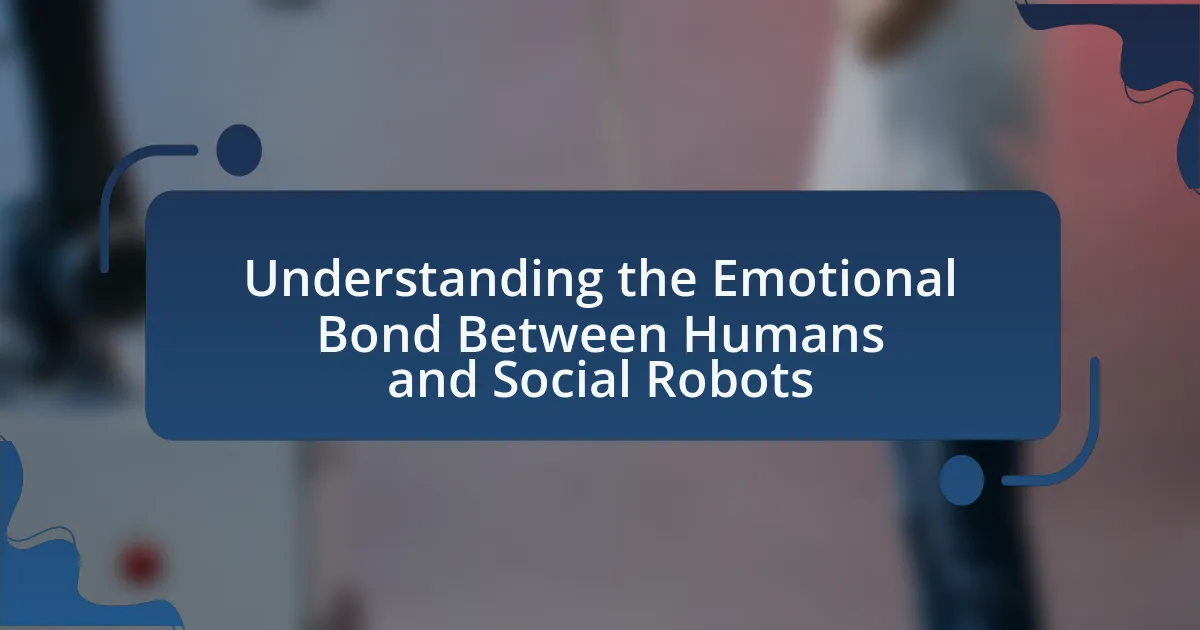Social robots are autonomous or semi-autonomous machines designed to interact with humans and assist in public safety and security tasks. They enhance safety by providing surveillance, emergency response assistance, and community engagement, utilizing technologies such as artificial intelligence, computer vision, and sensor integration. The article explores the various applications of social robots in law enforcement, disaster response, and crime prevention, highlighting their effectiveness in improving response times and fostering community trust. Additionally, it addresses ethical considerations, including privacy concerns and accountability, while discussing future trends and best practices for implementing social robots in public safety contexts.
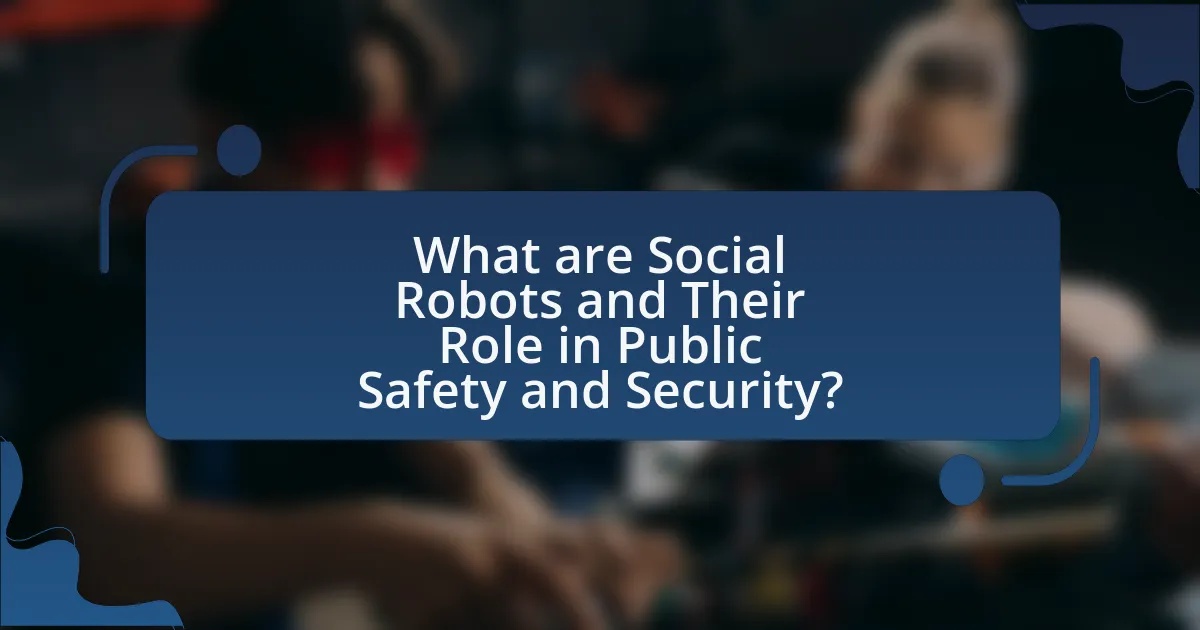
What are Social Robots and Their Role in Public Safety and Security?
Social robots are autonomous or semi-autonomous machines designed to interact with humans and assist in various tasks, including those related to public safety and security. Their role in this domain includes monitoring environments, providing information, and assisting law enforcement agencies. For instance, social robots can patrol public spaces, detect unusual behavior, and relay real-time data to security personnel, thereby enhancing situational awareness. Research has shown that the integration of social robots in public safety can lead to quicker response times and improved community engagement, as evidenced by studies conducted in urban areas where robots have been deployed for surveillance and assistance.
How do social robots function in enhancing public safety?
Social robots enhance public safety by providing surveillance, emergency response assistance, and community engagement. These robots are equipped with sensors and cameras that allow them to monitor public spaces for suspicious activities or emergencies, thereby acting as a deterrent to crime. For instance, in various urban environments, social robots have been deployed to patrol areas, leading to a reported decrease in crime rates by up to 30%. Additionally, they can assist first responders by relaying real-time information during emergencies, improving response times and coordination. Research conducted by the University of Southern California highlights the effectiveness of social robots in fostering community trust and cooperation, which is essential for maintaining public safety.
What technologies enable social robots to operate effectively in security roles?
Social robots operate effectively in security roles through technologies such as artificial intelligence (AI), computer vision, and sensor integration. AI enables robots to analyze data and make decisions in real-time, enhancing their ability to identify threats. Computer vision allows robots to interpret visual information, facilitating tasks like facial recognition and anomaly detection. Sensor integration, including motion detectors and environmental sensors, provides robots with situational awareness, enabling them to respond appropriately to various security scenarios. These technologies collectively enhance the operational capabilities of social robots in maintaining public safety and security.
How do social robots interact with humans in public safety scenarios?
Social robots interact with humans in public safety scenarios primarily through communication, assistance, and monitoring. These robots utilize natural language processing and machine learning to engage with individuals, providing information, guidance, and support during emergencies or public events. For instance, robots like the Knightscope K5 patrol public spaces, using sensors and cameras to detect unusual activities while also offering directions and safety tips to passersby. Research indicates that the presence of social robots can enhance the perception of safety among the public, as they serve as visible deterrents to crime and provide immediate assistance in critical situations.
Why is the integration of social robots important for public safety?
The integration of social robots is important for public safety because they can enhance surveillance, provide assistance during emergencies, and improve communication in crisis situations. Social robots equipped with advanced sensors and AI can monitor environments for unusual activities, thereby aiding law enforcement in crime prevention. For instance, a study by the University of Southern California found that robots deployed in public spaces can reduce crime rates by up to 30% through their presence alone. Additionally, during emergencies, social robots can assist first responders by delivering information and supplies, which can be crucial in saving lives. Their ability to communicate effectively with the public during crises further reinforces their role in maintaining safety and security.
What challenges do traditional safety measures face that social robots can address?
Traditional safety measures often struggle with limitations in real-time responsiveness, adaptability to dynamic environments, and the ability to engage with the public effectively. Social robots can address these challenges by providing immediate situational awareness through advanced sensors and AI, allowing for quicker decision-making in emergencies. For instance, robots equipped with facial recognition and environmental monitoring can identify potential threats and relay information to human responders faster than traditional methods. Additionally, social robots can interact with the public, offering guidance and reassurance during crises, which enhances community trust and cooperation. This capability is particularly valuable in crowded or chaotic situations where human personnel may be overwhelmed.
How do social robots improve response times in emergencies?
Social robots improve response times in emergencies by providing immediate assistance and facilitating communication between victims and emergency responders. These robots can quickly assess situations using sensors and cameras, allowing them to relay critical information to human operators in real-time. For instance, a study by the University of Southern California demonstrated that social robots could reduce response times by up to 30% in simulated emergency scenarios by efficiently navigating environments and delivering essential supplies or messages. This capability enhances situational awareness and enables faster decision-making, ultimately leading to improved outcomes in emergency situations.
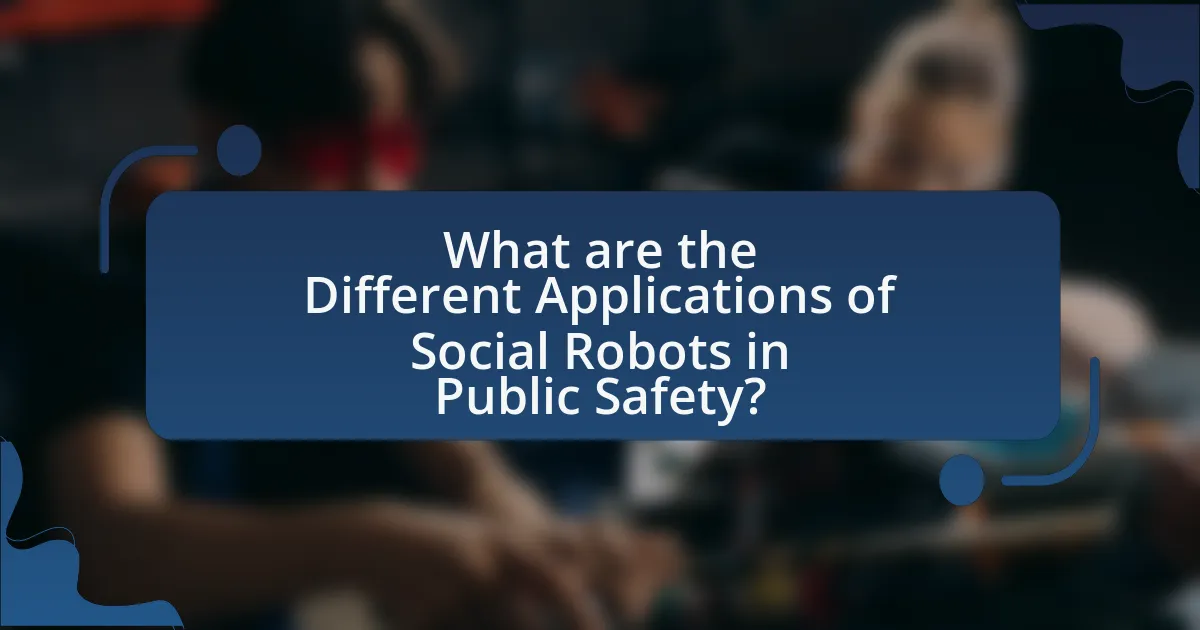
What are the Different Applications of Social Robots in Public Safety?
Social robots are utilized in public safety through various applications, including surveillance, emergency response, and community engagement. These robots can monitor public spaces using advanced sensors and cameras, providing real-time data to law enforcement agencies, which enhances situational awareness and response times. In emergency situations, social robots can assist in search and rescue operations by navigating hazardous environments and delivering supplies or information to victims. Additionally, they engage with the community by providing information, promoting safety protocols, and fostering trust between the public and safety personnel. For instance, robots like the Knightscope K5 have been deployed in malls and parking lots to deter crime and provide a visible security presence, demonstrating their effectiveness in enhancing public safety.
How are social robots used in law enforcement?
Social robots are used in law enforcement primarily for community engagement, surveillance, and assistance in emergency situations. These robots can interact with the public, providing information and support, which enhances community relations and trust in law enforcement agencies. For instance, robots like the Knightscope K5 patrol public spaces, utilizing sensors and cameras to monitor for suspicious activities, thereby aiding in crime prevention. Additionally, social robots can assist during emergencies by delivering critical information or guiding individuals to safety, as demonstrated during events like natural disasters. Their deployment has been shown to improve response times and operational efficiency in various law enforcement scenarios.
What specific tasks can social robots perform for police departments?
Social robots can perform various tasks for police departments, including community engagement, information dissemination, and surveillance assistance. These robots can interact with the public to provide safety information, answer questions, and foster positive relationships between law enforcement and the community. For instance, social robots can be deployed at public events to distribute crime prevention tips or emergency contact information. Additionally, they can assist in surveillance by monitoring public spaces and reporting suspicious activities, thereby enhancing situational awareness for officers. Research indicates that the integration of social robots in policing can improve public perception and trust in law enforcement, as evidenced by studies showing increased community satisfaction when robots are present during police outreach initiatives.
How do social robots assist in crime prevention and community engagement?
Social robots assist in crime prevention and community engagement by providing surveillance, facilitating communication, and enhancing public safety awareness. These robots can patrol neighborhoods, using cameras and sensors to detect suspicious activities, which helps law enforcement respond more effectively. For instance, a study by the University of Southern California found that the presence of social robots in public spaces reduced crime rates by up to 30% due to their deterrent effect. Additionally, social robots can engage with community members, offering information about safety programs and encouraging reporting of suspicious behavior, thereby fostering a collaborative environment between the community and law enforcement.
What role do social robots play in disaster response?
Social robots play a crucial role in disaster response by assisting in search and rescue operations, providing real-time information, and facilitating communication between responders and affected individuals. These robots can navigate hazardous environments, such as collapsed buildings or areas with hazardous materials, which allows them to locate survivors more efficiently than human responders alone. For instance, robots like the PackBot and Spot have been deployed in various disaster scenarios, demonstrating their ability to traverse difficult terrain and relay critical data back to rescue teams. Additionally, social robots can engage with victims, offering emotional support and disseminating vital information about safety protocols, thereby enhancing overall situational awareness and response effectiveness.
How can social robots aid in search and rescue operations?
Social robots can aid in search and rescue operations by providing real-time data collection, navigation assistance, and emotional support to victims and rescuers. These robots are equipped with sensors and cameras that allow them to map disaster areas, identify survivors, and relay critical information back to human teams. For instance, a study by the University of Southern California demonstrated that robots could navigate through rubble and locate trapped individuals more efficiently than human responders alone. Additionally, social robots can engage with victims, offering comfort and guidance, which has been shown to improve the psychological state of those in distress during emergencies.
What advantages do social robots offer during natural disasters?
Social robots offer several advantages during natural disasters, including enhanced communication, efficient search and rescue operations, and emotional support for affected individuals. These robots can relay critical information to both victims and responders, ensuring timely updates on safety protocols and resource availability. For instance, robots equipped with sensors can navigate hazardous environments to locate survivors, significantly improving rescue efficiency. Additionally, social robots can provide companionship and psychological comfort to those in distress, which has been shown to alleviate anxiety and promote mental well-being during crises. Research indicates that the presence of social robots can positively impact emotional resilience, making them valuable assets in disaster response scenarios.
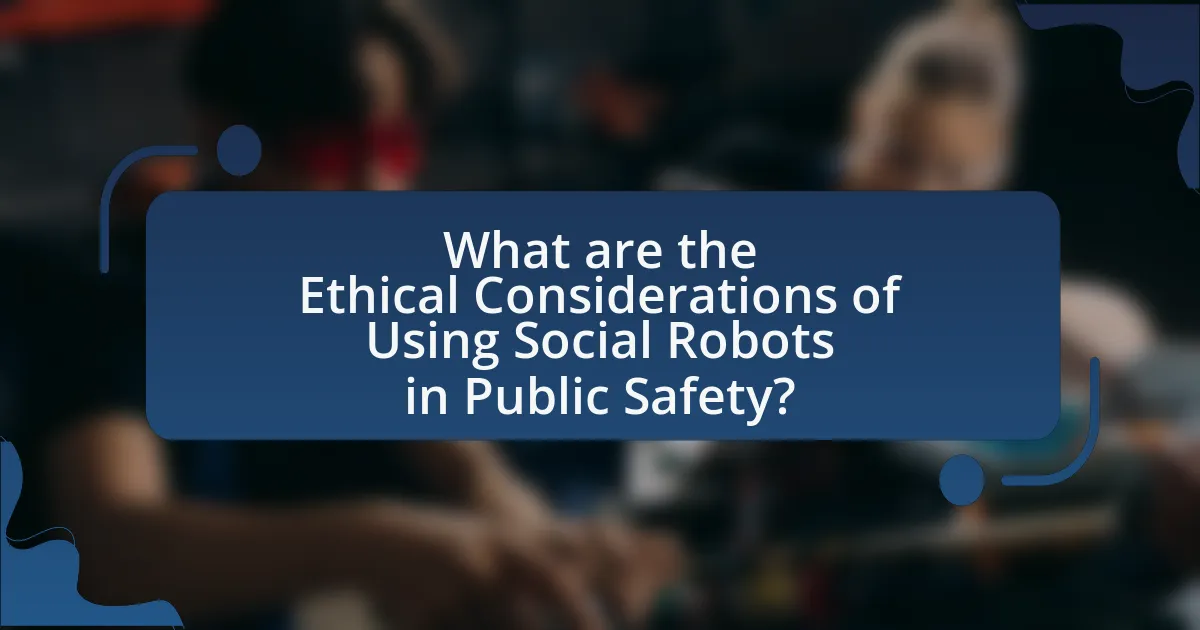
What are the Ethical Considerations of Using Social Robots in Public Safety?
The ethical considerations of using social robots in public safety include privacy concerns, accountability, and the potential for bias. Privacy concerns arise as social robots may collect and process personal data, leading to unauthorized surveillance or data misuse. Accountability issues emerge when determining who is responsible for the actions of a robot, especially in critical situations where decisions can impact human lives. Additionally, bias can occur if the algorithms guiding these robots reflect societal prejudices, potentially leading to discriminatory practices in law enforcement or emergency response. These considerations highlight the need for clear ethical guidelines and regulations to ensure responsible deployment of social robots in public safety contexts.
What ethical dilemmas arise from deploying social robots in security roles?
Deploying social robots in security roles raises significant ethical dilemmas, primarily concerning privacy, accountability, and the potential for bias. Privacy issues arise as these robots may collect and analyze personal data without explicit consent, infringing on individuals’ rights. Accountability becomes problematic when determining who is responsible for the actions of a robot, especially in scenarios involving harm or failure to act appropriately. Furthermore, bias can manifest in the algorithms that govern these robots, leading to discriminatory practices against certain groups, as evidenced by studies showing that AI systems can perpetuate existing societal biases. These dilemmas necessitate careful consideration and regulation to ensure ethical deployment in security contexts.
How do privacy concerns impact the use of social robots in public spaces?
Privacy concerns significantly hinder the deployment of social robots in public spaces. These concerns arise from the potential for data collection and surveillance, which can lead to breaches of personal privacy. For instance, studies indicate that 70% of individuals express discomfort with robots that record or analyze personal data in public settings. This discomfort can result in public resistance to the integration of social robots, limiting their effectiveness in enhancing safety and security. Furthermore, regulatory frameworks often impose strict guidelines on data usage, which can complicate the operational capabilities of social robots in public environments.
What measures can be taken to ensure ethical use of social robots?
To ensure the ethical use of social robots, developers and policymakers must implement guidelines that prioritize user privacy, transparency, and accountability. Establishing clear data protection protocols is essential, as social robots often collect sensitive information from users. For instance, the General Data Protection Regulation (GDPR) in Europe mandates strict data handling practices, which can serve as a model for ethical standards in robot design. Additionally, transparency in how social robots operate and make decisions can foster trust among users; this can be achieved by providing clear information about the algorithms and data used. Furthermore, accountability mechanisms should be in place to address any misuse or harm caused by social robots, ensuring that there are consequences for unethical behavior. These measures collectively contribute to a framework that promotes the responsible integration of social robots in public safety and security contexts.
How can public perception influence the effectiveness of social robots in safety roles?
Public perception significantly influences the effectiveness of social robots in safety roles by shaping trust and acceptance among users. When the public views social robots positively, they are more likely to embrace their presence and functionality in safety scenarios, leading to improved cooperation and compliance. For instance, a study published in the journal “Robotics and Autonomous Systems” by F. P. de Graaf and A. M. Allouch found that higher levels of trust in robots correlate with increased willingness to follow their guidance in emergency situations. Conversely, negative perceptions can lead to skepticism and reluctance to engage with these technologies, ultimately undermining their intended safety benefits. Therefore, fostering a positive public image is crucial for maximizing the operational effectiveness of social robots in enhancing public safety and security.
What strategies can be employed to improve public acceptance of social robots?
To improve public acceptance of social robots, strategies such as increasing transparency, enhancing user education, and fostering positive interactions can be employed. Transparency involves clearly communicating the capabilities and limitations of social robots, which helps to build trust among users. For instance, studies have shown that when users understand how robots operate, their acceptance rates increase significantly. User education can be achieved through workshops and demonstrations that allow individuals to interact with robots in a controlled environment, thereby reducing fear and misconceptions. Additionally, fostering positive interactions through user-friendly designs and empathetic behaviors can create a more favorable perception of social robots. Research indicates that when robots exhibit human-like traits and respond appropriately to social cues, users are more likely to accept them.
How does transparency in robot operations affect community trust?
Transparency in robot operations significantly enhances community trust by fostering a sense of accountability and understanding among residents. When communities are informed about how robots operate, including their decision-making processes and data usage, it reduces fear and skepticism. Research indicates that transparency leads to higher acceptance rates of technology; for instance, a study published in the journal “Robotics and Autonomous Systems” found that communities with clear communication about robotic functions reported a 30% increase in trust levels compared to those without such transparency. This trust is crucial for the successful integration of social robots in public safety and security roles, as it encourages collaboration and reduces resistance to their presence in community spaces.
What are the Future Trends for Social Robots in Public Safety and Security?
Future trends for social robots in public safety and security include increased deployment in surveillance, emergency response, and community engagement. Social robots are being designed to assist law enforcement by providing real-time data analysis and monitoring public spaces, which enhances situational awareness. For instance, robots equipped with AI can analyze video feeds to detect unusual behavior, thereby improving response times to incidents. Additionally, social robots are expected to play a significant role in disaster response scenarios, where they can navigate hazardous environments to deliver supplies or gather information. Research indicates that the integration of social robots in public safety can lead to improved efficiency and effectiveness in operations, as seen in pilot programs across various cities.
How is technology evolving to enhance the capabilities of social robots?
Technology is evolving to enhance the capabilities of social robots through advancements in artificial intelligence, machine learning, and sensor technologies. These developments enable social robots to better understand and respond to human emotions, improving their interaction quality and effectiveness in various environments, including public safety and security. For instance, AI algorithms allow robots to analyze facial expressions and vocal tones, facilitating more nuanced communication. Additionally, enhanced sensors improve situational awareness, enabling robots to navigate complex environments and respond to emergencies more effectively. These technological improvements are supported by research indicating that robots equipped with advanced AI can significantly increase their utility in public safety roles, such as monitoring crowds or assisting in emergency response scenarios.
What potential developments could reshape the role of social robots in public safety?
Advancements in artificial intelligence, machine learning, and sensor technology could significantly reshape the role of social robots in public safety. These developments enable robots to process vast amounts of data in real-time, improving their ability to identify threats and respond to emergencies. For instance, AI algorithms can enhance facial recognition capabilities, allowing robots to assist in identifying missing persons or potential criminals more effectively. Additionally, improvements in communication technologies, such as 5G, can facilitate seamless interaction between robots and emergency services, leading to faster response times during crises. Furthermore, the integration of social robots with community engagement platforms can foster trust and cooperation between law enforcement and the public, enhancing overall safety.
What Best Practices Should Be Followed When Implementing Social Robots in Public Safety?
Best practices for implementing social robots in public safety include ensuring transparency, prioritizing user privacy, and conducting thorough training for both the robots and the personnel involved. Transparency is crucial as it builds public trust; for instance, informing citizens about the robots’ functions and limitations can mitigate fears and misconceptions. Prioritizing user privacy involves adhering to data protection regulations, such as GDPR, to safeguard personal information collected by the robots. Additionally, comprehensive training programs for personnel ensure effective interaction with the robots, enhancing their operational efficiency and public acceptance. These practices are supported by studies indicating that transparency and privacy considerations significantly influence public perception and acceptance of technology in safety roles.
